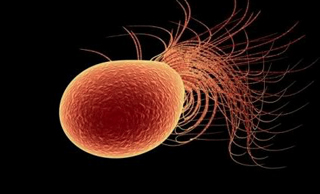By Mark Ellis

Some believe human beings evolved from a single-celled creature, which gradually becoming more and more complex over a vast time span. But what if the oldest single-celled bacteria ever found contained intricate, synchronized motors more complex than a Boeing 747?
In November, 2012, two scientific groups from Osaka University in Japan and Aix-Marseille Université in France made a startling discovery.
They set out to uncover the power behind the tiny tails (flagella) that allowed the MO-1 marine bacterium to swim. Using electron cryotomography—an electron microscope and very cold temperatures — they found this “simple” creature’s tails are powered by seven motors, arranged in a hexagonal array, with all gears interacting with 24 smaller gears between them.
“This is the earliest bacteria ever found,” says Mark Rose, founder of Genesis Alive. “They found it in rock they claim is three billion years old,” he notes. “That means it’s the oldest, most complete single cell.”

“The seven tails (flagella) rotate one way, and the smaller gears rotate the opposite way to maximize torque while minimizing friction,” Rose notes.
These gears or bearings enable the flagella to spin very fast—so the MO-1 can swim ten times faster than E. coli and Salmonella. Some have referred to this as “the Ferrari of flagella,” due to its speed and advanced design.
“This discovery baffled the microbiological world with it’s uncanny complexity,” Rose notes. “Think of it, not one but seven proton synchronized motors interconnected with a planetary gearbox.”
“The seven flagella propellers are inter-linked for minimum drag profile and maximum thrust by using 24 gears and a sheath, similar to modern aircraft and mufti-engine helicopters!”
“It actually has gears and it keeps all seven motors synchronized,” he notes. “Typically, any geared engines have no more than two motors. The best we could do in a helicopter is three engines and a multiple gear box to sync the engines.”
“If every school kid understood how that little thing works, the whole paradigm of evolutionary thought would have to change.”
Rose observes the axial proton motor is almost identical to modern AC (alternating current) brushless motors. “It has no wires, bearings or metal, and is 1/200,000 smaller than man’s best device.”
“The motors can drive the MO-1 bacteria at relative speeds of 100 body lengths/second. A Cheetah achieves a land speed of only 25 body lengths/second in comparison and that’s in air, not fluid!” he says.
This “simple” bacterium has nearly the same number of parts as a Boeing 747 — six million — which like the aircraft, work together perfectly. But these parts allow the bacterium to do something the 747 can’t do – multiply itself. Note, the MO-1 bacterium has three more motors than the Boeing model.
Well-known evolutionist, Dr. Francisco Ayala of UC Irvine, has calculated the odds of human beings evolving from a single bacterium to be 1 in 10 to the 1 millionth power. However, three physicists, John Barrow, Brandon Carter and Frank Tipler, reexamined his data and said he overlooked several critical factors. They stated the odds at 1 in 10 to the 24 millionth power.
But according to probability theorists, any event with lower odds than 1 in 10 to the 50th power is considered mathematically impossible.
Do you want to know God personally? Here are four steps...




Interesting article, but I cannot find confirmation that MO-1 is the bacterium found “in rock they claim is three billion years old”. The reference link at Genesis Alive talks about Prokaryote bacteria being found in the oldest known rocks on earth, but not MO-1 specifically. Do you have a clearer reference?
It’s a pure prokaryote bacterium, the same ones evolutionists have claimed for years coming direct from dead chemicals and primordial to all life. These are single celled creatures that replicate using binary fusion. At any rate, most prokaryotes have flagella with the same proton powered axial shaft engine. The development of these engines alone is utterly impossible to conceive from mindless self-made evolutionary processes. see –
http://www.genesisalive.com/the-question-of-complexity.html for more. Now cometh the MO-1, it has a gearbox..
Thanks for the response Mark. I agree with you about the impossibility to “evolve” a single flagellar motor, much less a hyperdrive such as the one found in MO-1. However it may seem misleading, or even disingenuous, to some to seem to claim MO-1 is the Prokaryote that was found “in rock they claim is three billion years old”. You seem to be making that claim in your article, and the title of your OP states “Earliest single-cell bacteria contained seven complex motors”. I’m just trying to help you avoid making unsubstantiated claims that may give opponents to our view any ammunition against us.
A prokaryote with one motor, none or seven is still a prokaryote, like a bird is a bird. All the lit in prokaryote Ed at the college level discusses the motor, so when do we disconnect the two as Modern science doesn’t. They are embarrassed enough dealing with one motor evolving, now they have 7.
Their typical staged response now is “Behe lost in court” haha. (see Darwin’s Black Box, in its 10th printing). So am I getting from you there was a pre-prokaryote? No, there has never been one found, Prokaryote’s always appear complete and fully formed, complete with over 4 millon DNA codons written in a perfect triple code, the same as in all living systems. Also, are we going down the common decent path? – e.g. if e.coli had one, could it have evolved into seven? No, they were created together as part of a complete ecosystem perfectly designed by God, and such change is prohibited in the DNA as cells have no write heads only reading ones. The MO-1 includes a magnetic iron based sensor to navigate and is a marvel of chemistry, surviving in water near volcanic vents. It has the ability to ionize (synthesize) its own internal chemistry, another amazing function of this tiny fast swimming laboratory. The flagella issue has been debated and the consensus was they are to fragile to fossilize and detect. No evolutionist in their right mind would try to defend the age/complexity issue using prokaryotes. In fact the order of the day is stay clear of them in public, cry in the closets. I can prove this, since I brought this issue into public debate, Wiki changed its wording about the subject of prokaryote origins dramatically.
Hello Mark,
I use these responses when dealing with evolutionists.
All you evolutionists have are Weasel Words.
A weasel word (also, anonymous authority) is an informal term[1] for equivocating words and phrases aimed at creating an impression that something specific and meaningful has been said, when in fact only a vague or ambiguous claim has been communicated. Additionally, the definition of the word ‘weasel’ includes: n. a sneaky, untrustworthy, or insincere person; v. to manipulate shiftily.[10] A weasel word (or phrase) can quite likely be understood to come from a position of intending to manipulate the communication, in a sneaky or underhanded manner.
Definition Wiki
In the political sphere, this type of language is used to “spin” or alter the public’s perception of an issue. In 1916, Theodore Roosevelt argued that “one of our defects as a nation is a tendency to use …’weasel words’; when one ‘weasel word’ is used … after another there is nothing left”.[11] Definition by Wiki
Evolution:
An absurdity is a thing that is extremely unreasonable, so as to be foolish or not taken seriously, or the state of being so. “Absurd” is an adjective used to describe an absurdity, e.g., “this encyclopedia article is absurd.”[1] It derives from the Latin absurdum meaning “out of tune”, hence irrational.[2] The Latin surdus means “deaf”, implying stupidity.[1] Absurdity is contrasted with seriousness in reasoning.[3] In general usage, absurdity may be synonymous with ridiculousness and nonsense. In specialized usage, absurdity is related to extremes in bad reasoning or pointlessness in reasoning; ridiculousness is related to extremes of incongruous juxtaposition, laughter, and ridicule; and nonsense is related to a lack of meaningfulness. Wiki
SEVEN FLAGELLAR MOTORS IN ONE
https://www.youtube.com/watch?v=4_CCDgPNYCY
Comments are closed.